Germany undeniably has some of the most beautiful castles in Europe, if not the world. More than 1.5 million visitors come to see Germany’s fairytale castles every year and you could easily spend a month exploring all the German castles without getting bored.
Here’s a comprehensive list of the best castles in Germany you absolutely need to visit, whether you’re a castle fanatic like me or not.
1. Neuschwanstein Castle
UNESCO World Heritage site
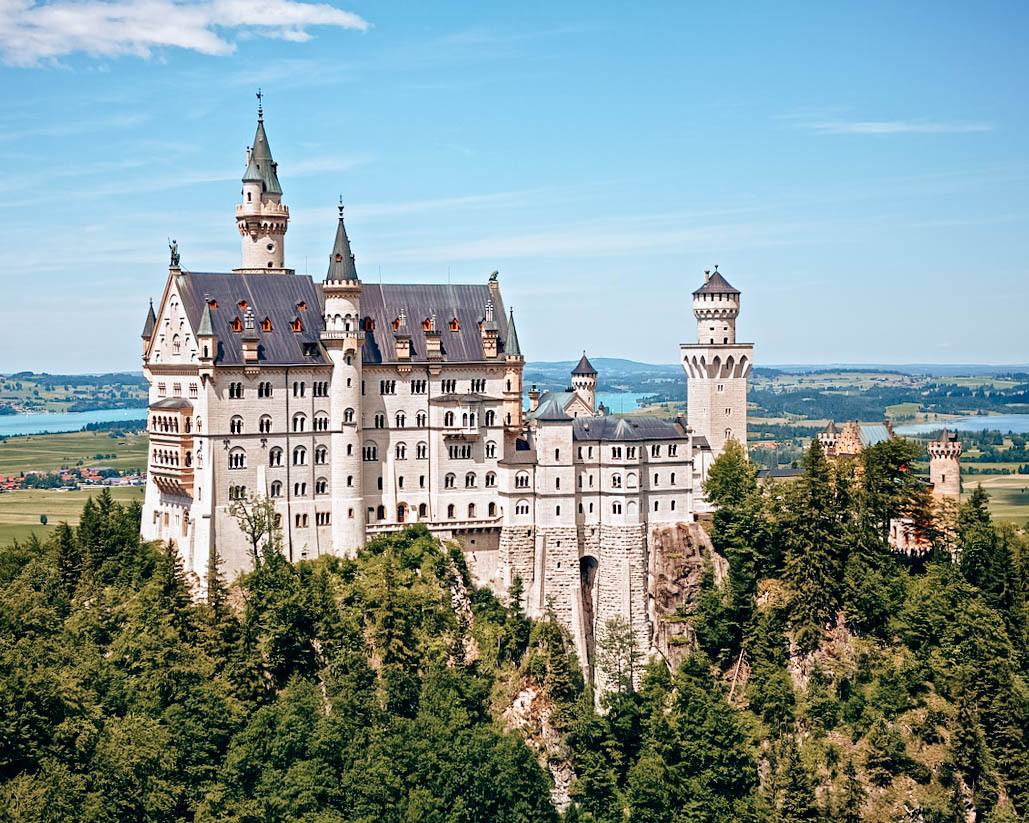
The most famous castle in Germany, the name of this castle literally translates to New Swan Stone castle. Its name wasn’t acquired until after the death of the Bavarian King Ludwig II (a.k.a The Swan King) and is thought to be a reference to Wagner’s character – the Swan Knight.
Located in Bavaria, the reasons behind the construction of this castle aren’t fully clear, as the King was declared insane and died of strange causes shortly before the castle was finished. However, it’s believed that his reasons were political and personal.
In 1866 when Prussia emerged victorious from the Austro-Prussian War, Bavaria was forced to accept an alliance with the Empire, thus losing its power. Neuschwanstein became the centerpiece of Ludwig II’s imagined kingdom, where he could act as a true royal on a two-story throne room inspired by Byzantine churches and a bedroom decorated with murals depicting the legend of Tristan and Isolde.
The only way to visit the castle is on a guided tour, each tour lasting 35 minutes and you aren’t allowed to take photographs or videos inside the castle. It’s essential to prebook your tickets in order to get your preferred time slot.
You can reach the castle by renting a car in Munich or Innsbruck like I did (find the best rental offers on Discover Cars), but if you don’t drive you can also pre-book an organized tour:
- Book a Full Day Tour to Neuschwanstein Castle & Linderhof Palace from Munich
- Book Skip the Line Entrance Tickets to Neuschwanstein Castle
2. Hohenschwangau Castle
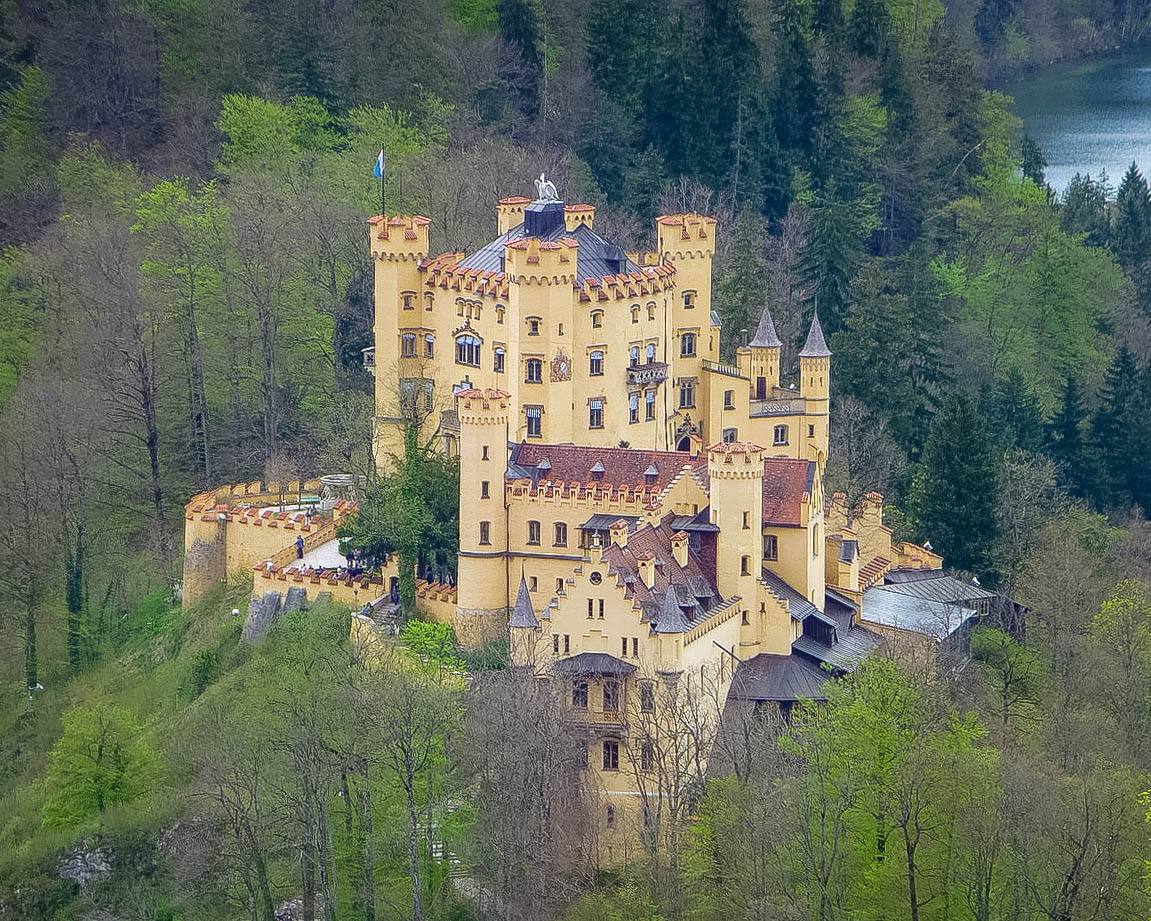
Hohenschwangau is the less popular sister of Neuschwanstein Castle with a bit less of the magic. During the late 18th century, it served as a residence for the rulers of the area but unfortunately got quite damaged over the years.
It wasn’t until the 19th century that King Ludwig’s father, Maximilian II, acquired the castle and restored it into a romantic palace inspired by the Gothic style of Neuschwanstein.
The castle can be visited on its own or as part of a combined ticket with Neuschwanstein.
3. Wartburg Castle
UNESCO World Heritage Site
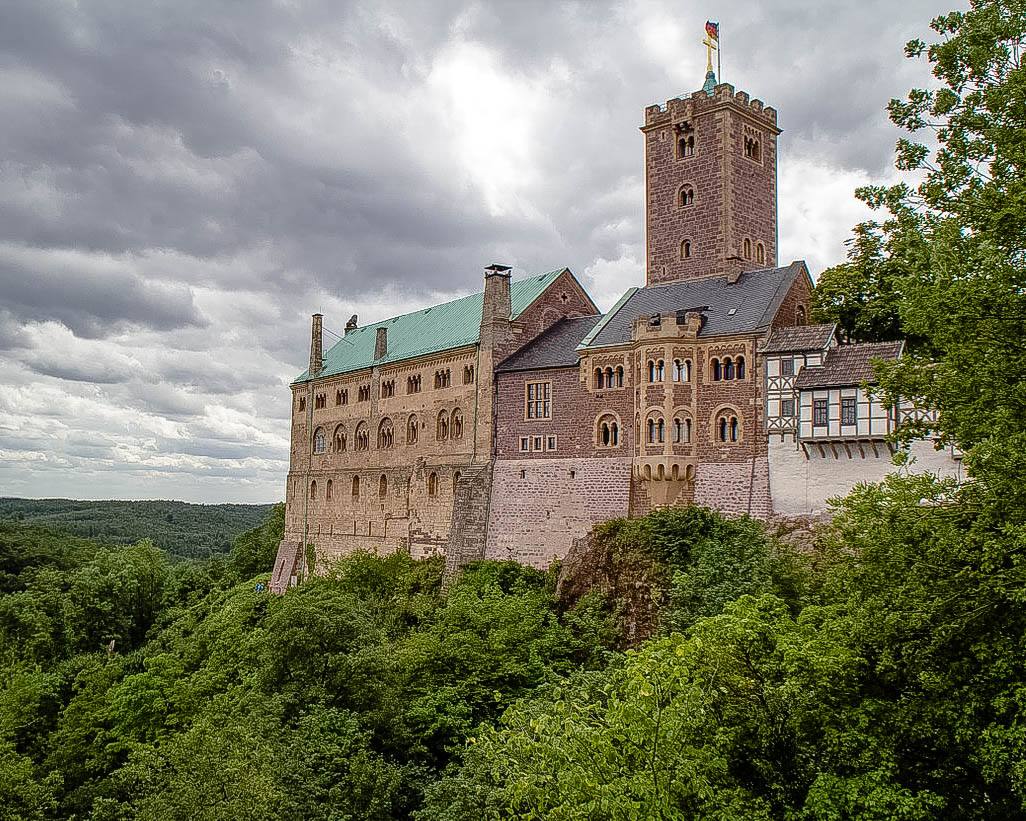
The word ‘Burg’ actually means ‘castle’ in German, hence the name Wartburg, or Wart Castle. Wartburg Castle was built in 1097 by a Frank count, Ludwig I of Thuringia, and unlike most castles, it has survived the elements, remaining structurally intact to the present day. It’s probably the castle that played the most important role in German history.
Martin Luther came to Wartburg after he was declared a heretic and hid from the Inquisition here for a year during 1521-22. Under the protection of German princes, he used his time in the Castle to translate the New Testament of the Bible into German. His powerful translation became the basis for the standard German we use today.
In 1817, a rally by some students took place whereby they urged for the unification of the German-speaking people and the democratization of the government. Although none of it was successful, the flag of one of the fraternities that were hoisted at the Wartburg during this time ended up being an inspiration for the current flag of Germany.
In order to visit the Castle, you need to prebook a guided tour which lasts around 45 minutes. The museum area and the Castle grounds can be visited at your leisure.
4. Drachenburg Castle
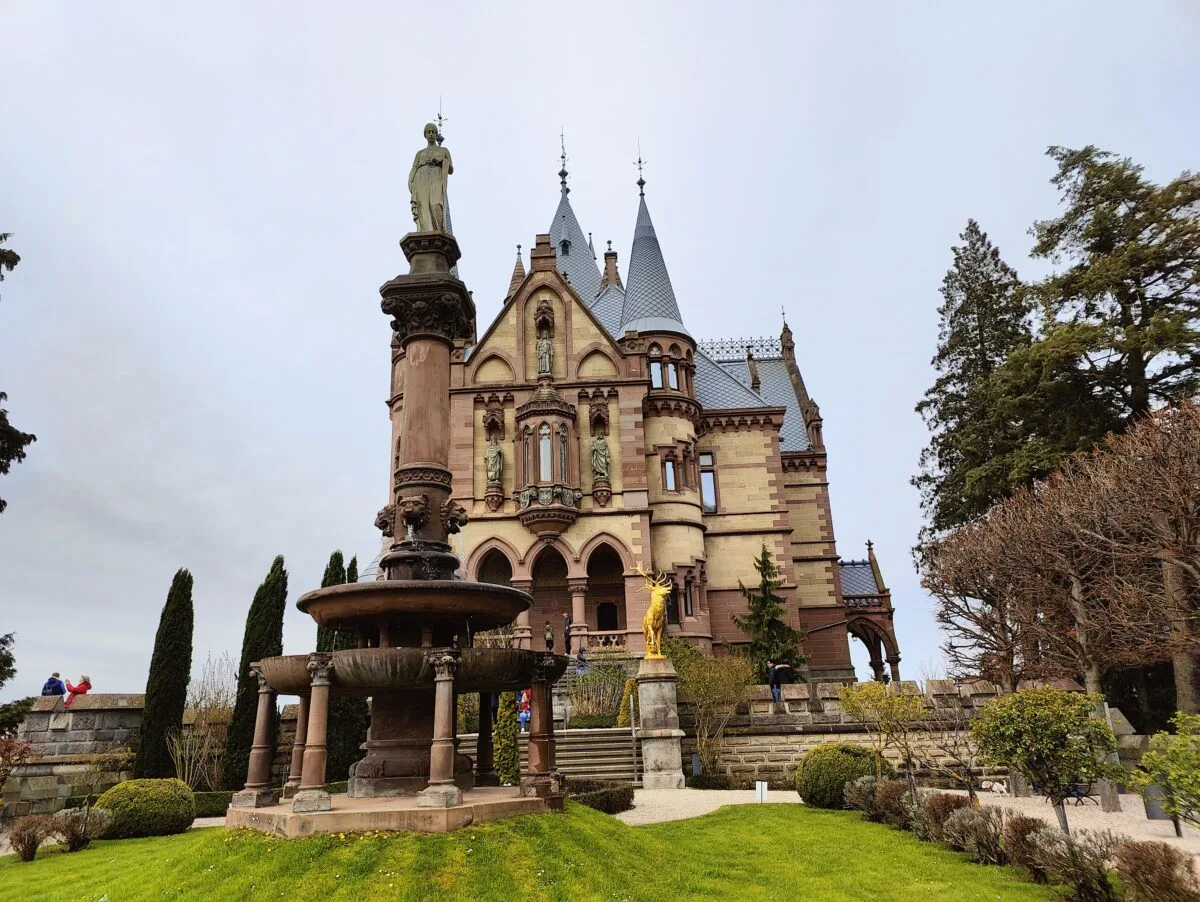
Another fairy tale like castle with towering pointed turrets, Drachenburg Castle, also known as Schloss Drachenburg and the Dragon Castle, is a private villa in Palace style constructed in the late 19th century. It was commissioned by Baron Stephan von Sarter who was a prominent figure in the area at the time but sadly, he personally never got a chance to live in the castle.
The place appears as a combination of castle, mansion, and villa and has a very rich history. During the Second World War, a very elite Nazi School moved in Drachenburg Castle, following which it was quite badly destroyed after it was bombarded during the war. It was then rebuilt in 1947 when it became a training center after being taken over by the German Rail Regional Office.
It was only in 1971 that the property was bought by a private owner, Paul Spinat, after having been abandoned for almost 10 years, and it was returned to its former glory and was listed as a monument in 1986.
The grounds are very well maintained with terraces offering excellent views up and down The Rhine. You can visit the castle via a guided tour of which they have several to choose from but you’re also free to visit the castle at your leisure with the help of the audio tour.
5. Burg Eltz – Rhine River Castle
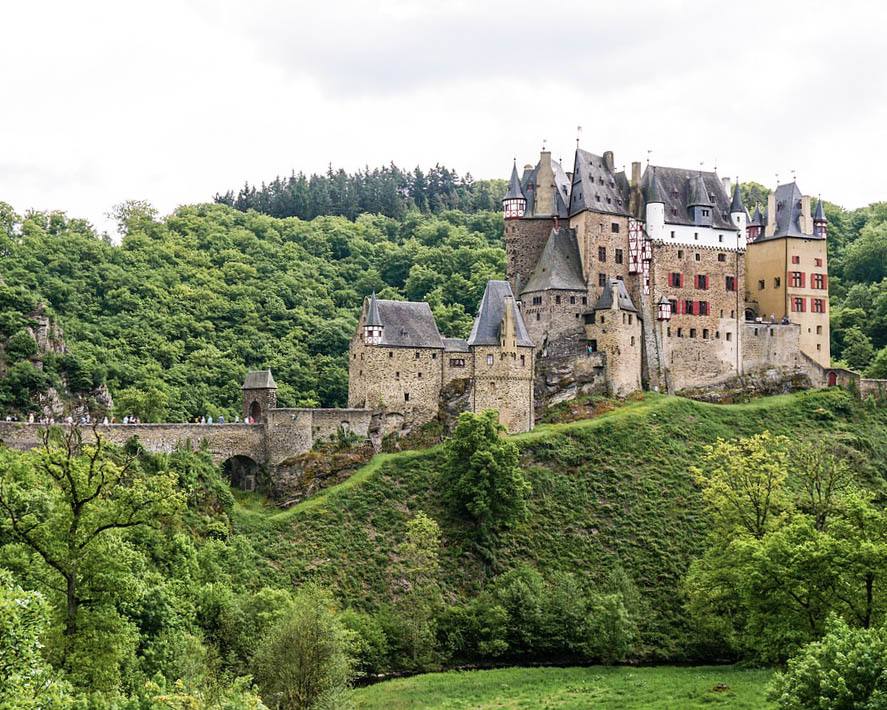
Burg Eltz was built in the 12th century and has been owned by the same family for over 850 years. But, it’s actually three castles in one. How come?
Since constructing a Medieval Castle was quite costly, three different branches of the Eltz family built entirely separate structures on the site of today’s castle. These separate buildings co-existed peacefully, with their residents sharing a central well and courtyard.
The Castle is hidden in deep woods and is filled with tantalizing secrets and 100 rooms. Inside the courtyard, you’d think you’ve come straight out of a Disney movie.
Tickets are sold only at the ticket window at the castle itself. Admission is €10 for adults and €6.50 for children and students.
6. Hohenzollern Castle
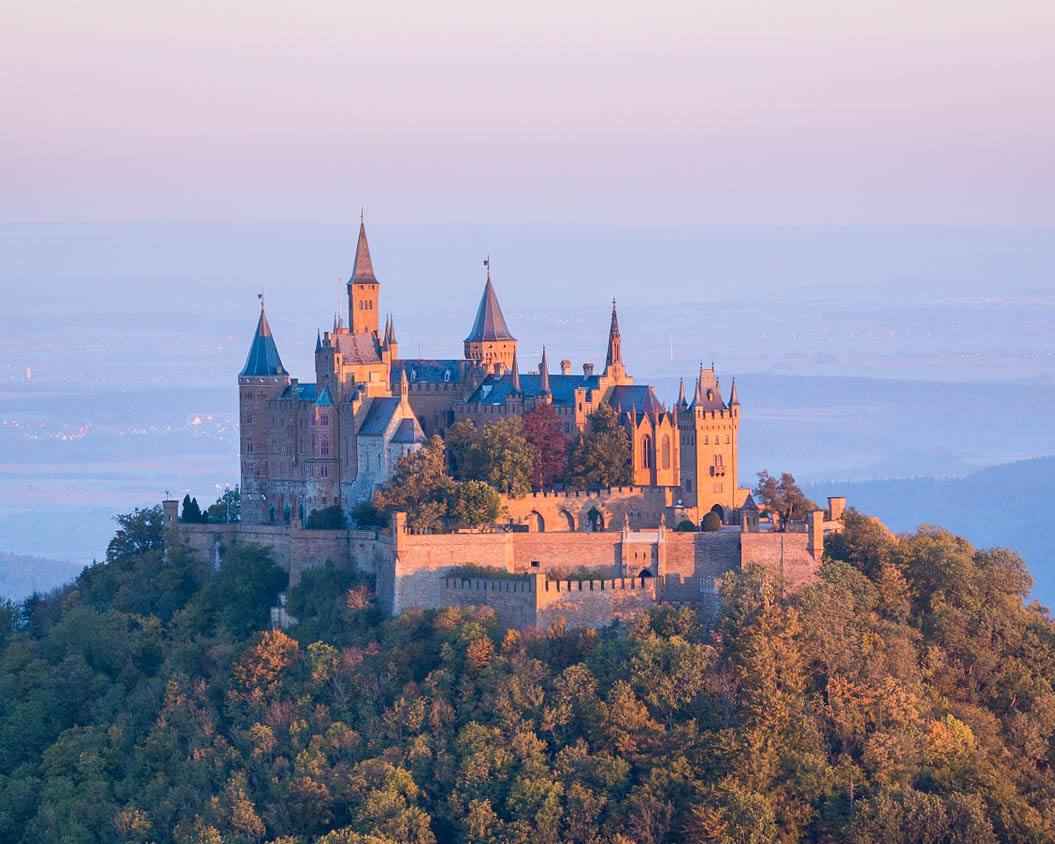
The castle, which sits right on top of Mount Hohenzollern, is well known by locals for its connection with the Legend of the White Lady of Hohenzollern that Germans are terrified of as she is said to bring bad luck.
Legend has it that Countess Kunigunde von Orlamonde, who in life was a widow and a mother of two children, wanted to marry Albrecht von Hohenzollern. Her love was sadly not reciprocated and the young burgrave told her that he “could not marry her since there were four eyes in the way”.
She was under the impression that the 4 eyes of which he spoke were of her two children but in reality, the 4 eyes were those of Albrecht’s brothers. So, she pierced the skulls of her children with a golden needle and fled to Rome. She has since then reportedly been seen walking around on the ramparts of the castle of the Hohenzollerns on the heights of the Zollerberg.
7. Heidelberg Palace
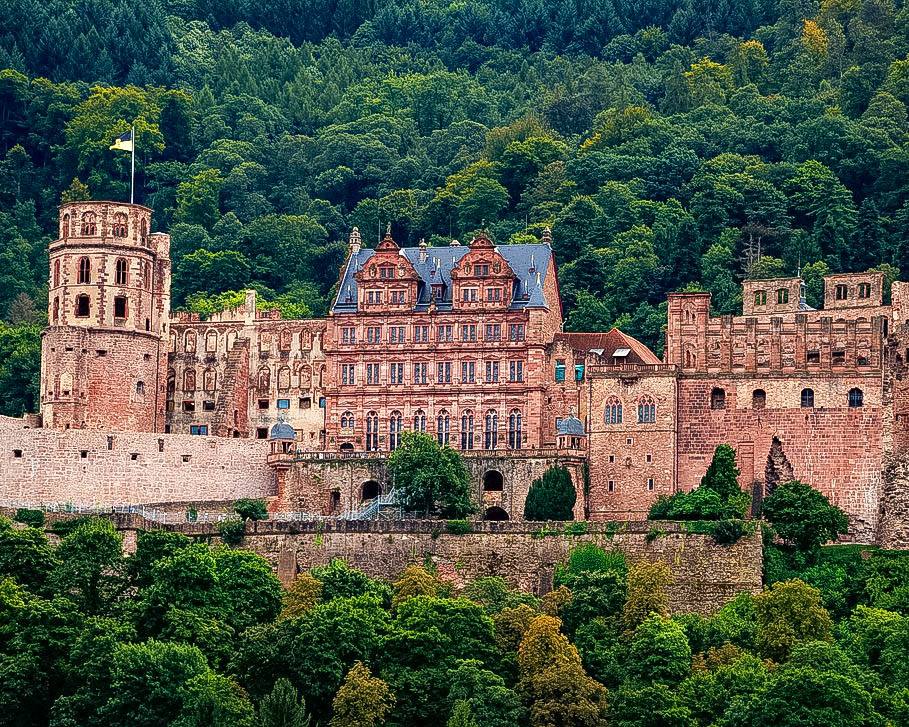
The stunning Heidelberg Palace sees over a million visitors every year and is one of the most important Rennaissance castles north of the Alps, due to it being one of the grandest architectural structures of its time. Records of the castle go as far back as 1225.
The palace is made up of several buildings surrounding the inner courtyard and each building was built in different centuries from 1300 all the way to the conservation of its ruins in 1800.
During the War of the Grand Alliance in the late 17th century, the palace was almost completely destroyed and this event is actually commemorated every year, several times a year, with a massive fireworks display (the first Saturday in June and September, and the second Saturday in July).
After having been repaired, the palace was once again destroyed in 1764 by two catastrophic lightning strikes. It was only in the 19th century that the prince-electors commissioned that the palace be repaired, although the project was never 100% completed.
A fun fact about the palace is that it houses the Heidelberg Tun ie. the “World’s Largest Wine Barrel” which is seven meters high, eight and a half meters wide and holds 220,000 liters (58,124 gallons) of wine. It was built by Prince Elector Karl Theodor to house the wine paid as taxes by the wine growers of the Palatine.
Similarly to other castles, you can only visit through a guided tour.
8. Frankenstein Castle

I’m sure you all know the story of Dr. Frankenstein, the eccentric alchemist who brought to life the nightmarish Frankenstein monster.
Well, there actually did once live an eccentric alchemist named Johann Konrad Dippel who lived in Frankenstein Castle during the late 1600s to early 1700s. He was rumored to experiment with potions and gruesome manipulations of body parts he stole from the cemetery, which then most likely became the subject of the very popular story by Mary Shelley.
Today, most of the castle lies in ruins, except for two of the towers, a restaurant, and the chapel but a lot of people still visit, especially around Halloween.
9. Lichtenstein Castle

The most prominent feature of this beautiful castle is that it sits right on the edge of the cliff overlooking the village of Honau. The current structure, which was rebuilt on top of the ruins of an even older castle, was completed in 1842 by the Duke of Urach and was inspired by a novel by the famous German writer poet and novelist Wilhelm Hauff.
The original castle, in fact, belonged to the Knights of Lichtenstein and when it was rebuilt in 1390 after war it was known to be one of the most impenetrable fortresses of the Middle Ages but sadly it lost its status over the years and was eventually demolished to be replaced by a hunting lodge – what a shame! That is until it was bought by Dr. Wilhelm Duke of Urach Count of Württemberg in 1837.
A basic tour of the castle lasts about 30 minutes and costs 8 € for adults and 3.50 € for children but you have to make a reservation in advance either by giving them a call or by email.
You’re also able to walk about “Württemberg´s fairytale castle” grounds and immerse yourself of the 19th-century beauty of the area.
10. Moritzburg Castle
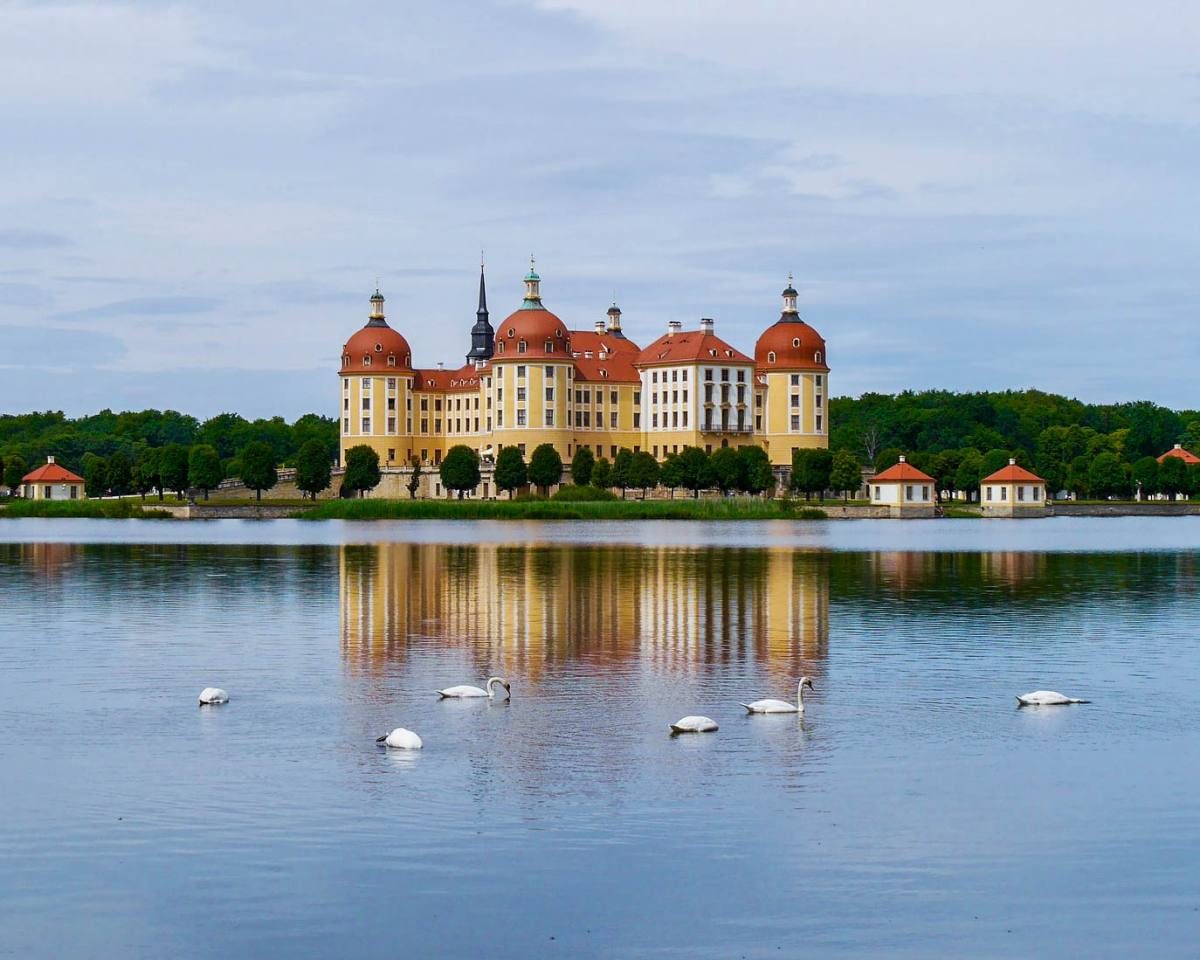
A Baroque-style castle originally built in 1542 in the Rennaisance style, Moritzburg Castle was a hunting lodge for Moritz of Saxony, the then Duke of Saxony. Between 1723 and 1733, the Elector Augustus II the Strong had the castle renovated and intended for it to be a lavish pleasure palace to hold feasts after hunts. It was intended to house exotic plants and animals and housed fine art.
One of the highlights of the castle is the Little Pheasant Castle, built in the Rococo style, which actually houses Saxony’s only lighthouse and after a complete restoration of its world reknown wall tapestries in 2013, the castle counts as one of the most artistically and historically important monuments in Germany today.
As of 1933, it was used as a residence by Wettin Prince Ernst Heinrich of Saxony until the castle was acquired by the Soviets in 1945. Most of the precious art was actually buried in the castle grounds by the Prince in order for them not to be found and was only unearthed much after the war in 1996.
The beauty of the castle is that it actually lies on a symmetrical artificial island on the lake. To this day, regular services are held in the chapel on the castle grounds which was built in 1661.
You can purchase tickets to visit the castle at the box office or you can book in advance of your visit as well but prices are a bit higher with the latter. All of the various ticket options can be found on their website, this includes admission tickets for the castle as well as exhibitions that they sometimes host.
11. Moyland Castle
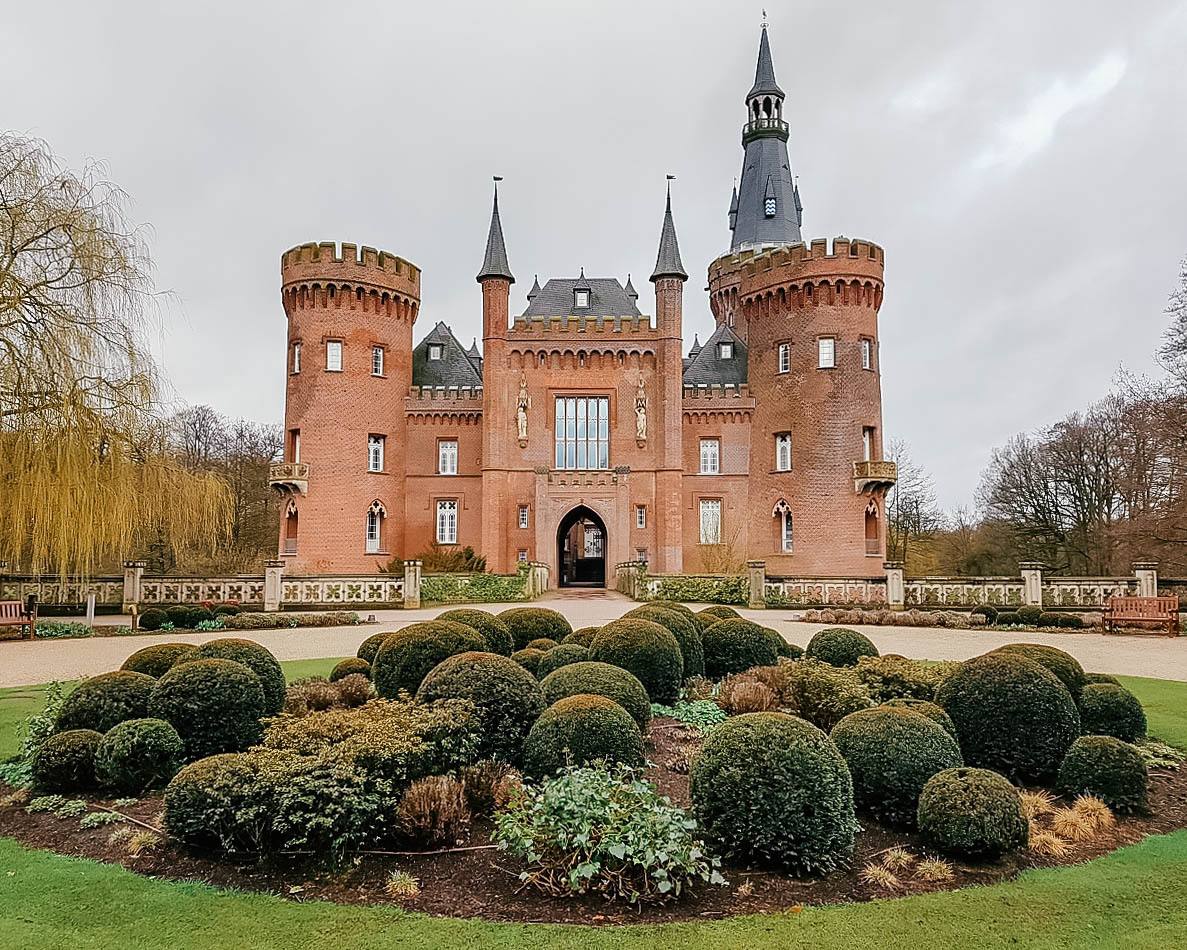
Moyland Castle in Bedburg-Hau, surrounded by a medieval moat straight out of a storybook, was originally constructed in the 14th century and has been remodeled several times over the centuries.
In the 19th century, master builder of Cologne Cathedral Ernst Friedrich Zwirner reconstructed the castle in its current neo-gothic Baroque style. It was used as a residence up until 1945 by the von Steengracht family who had bought the castle as far back as 1766.
The castle suffered severe damage during the Second World War, after which it was renovated and reopened as a museum under the Museum Schloss Moyland Foundation in 1990.
12. Schwerin Castle
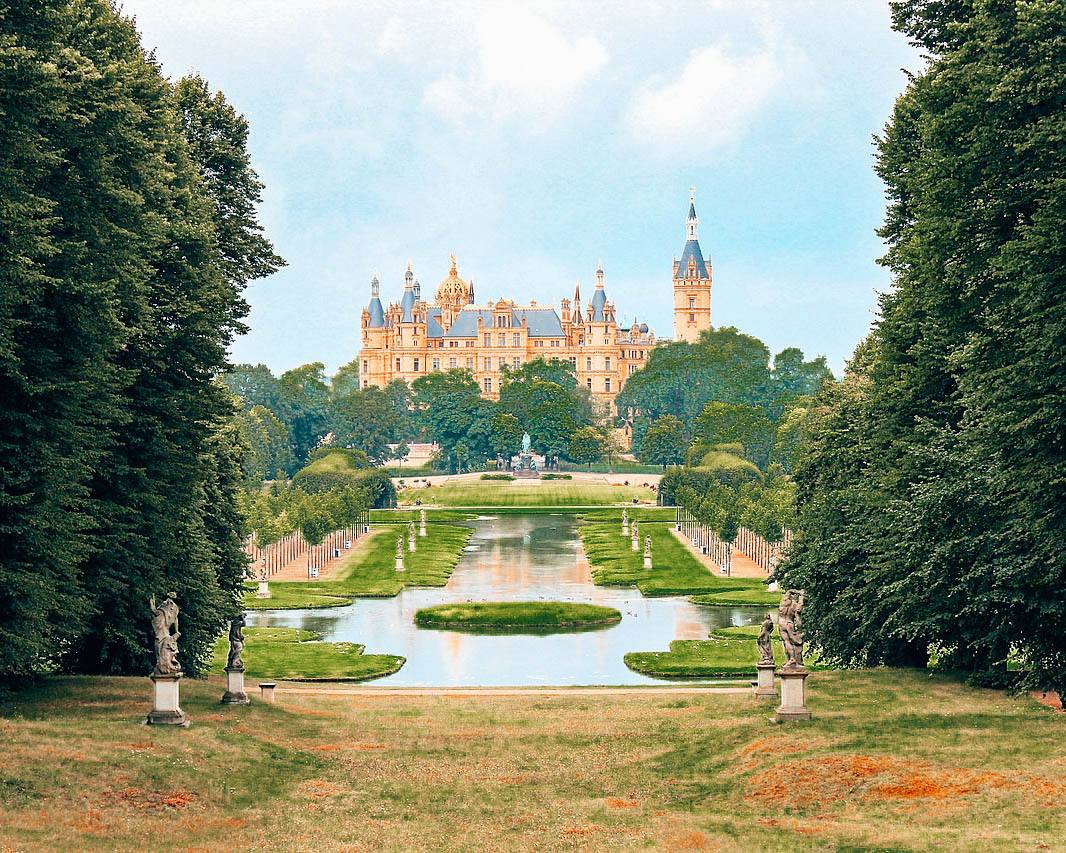
This romantic fairytale castle was built in 1857 and served as the residence of the Grandduke Friedrich Franz II of Mecklenburg-Schwerin. Today, although not lived in, it still maintains a prominent role in the area as it is the seat of Parliament.
The castle itself, although being several hundred years old, lies on the remains of fortresses that have been dated as far back as the year 942. The current structure was built by the Grandduke and it is sometimes called “Neuschwanstein of Northern Germany” relating it to the neo-medieval castle in the Bavarian mountains. Both castles were built to remind and imitate ancient and medieval castles.
But would you really have a fairy tale castle without a fabulous ghost story to go with it? According to the stories, deep in the cellar vaults of the castle lives a goblin known as Petermännchen (Little Peter). There are different versions of the story of Little Peter but the Grandduke actually had a room built for the ghost when he reconstructed the castle.
He’s meant to be quite a noble ghost who rewards those who have been good and punishes those who have been bad, so I’m sure you have nothing to worry about when you pay the castle a visit!
13. Albrechtsburg
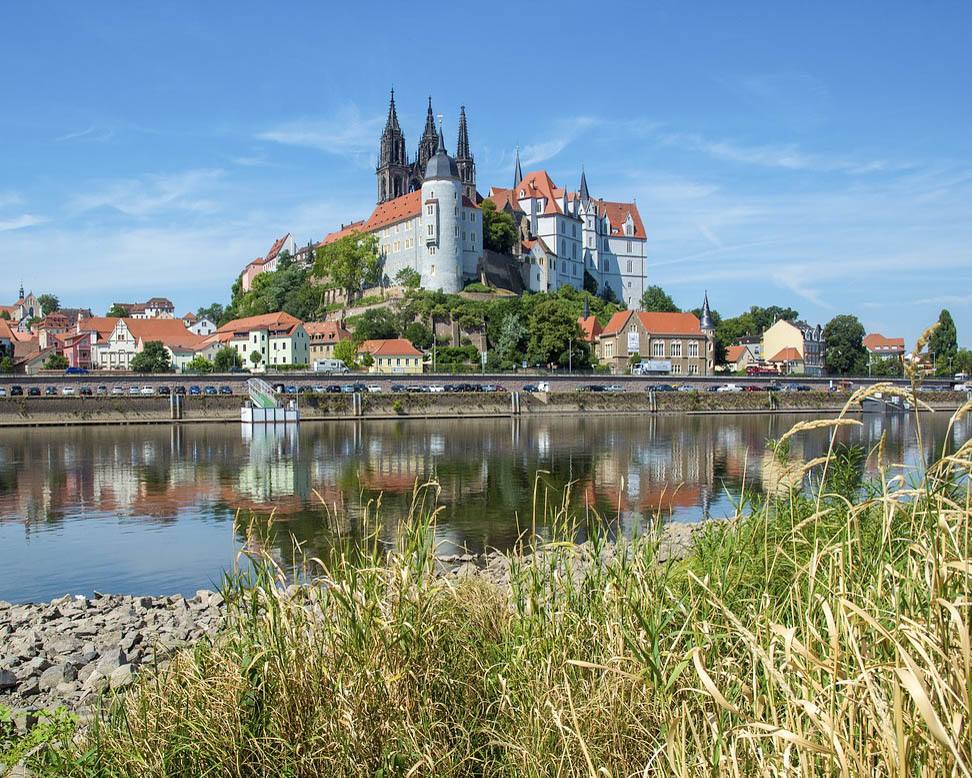
Situated over the beautiful Elbe River, the Albrechtsburg is known as Germany’s oldest palace building and was built in the 15th century as both a representative administration center and the residential palace for the two brothers Ernest and Albert of Wettin.
Before that, the fortress that lay overlooking the Elbe belonged to King Henry I and became to be known as the Cradle of Saxony because Meissen the center of the march of the same name bordering on the territories to the east that were still under Slavic control.
After conflict arose between the brothers Ernest and Albert, the castle came under the command of Augustus the Strong and in 1710 it became Europe’s first porcelain manufactory. This production ran for nearly 150 years until 1863 when Germany received money from after the German-French wars, reparation and restoration of the castle could be funded.
It was known to be one of the most revered architectural structures of its time because of its innovative architecture.
14. Sanssouci Palace
UNESCO World Heritage Site
Once the summer home of Frederick the Great, Sanssouci Palace when translated in French means ‘without a care’. Built between 1745 and 1747, the palace lies surrounded by a pristine landscape, a vineyard and several orchards and fruit trees. Its architectural and interior splendor is often deemed as rivaling even that of Versailles in France.
The king was known to be a humble man and had built the castle so he could retreat from the difficulties of his life with his dogs. He had thought of the palace as his personal sanctuary and had actually requested to be buried there but sadly, his wishes were not granted until the German reunification in 1990.
The gravestone over his tomb, which lies not far from where his dogs were buried (as was his wish) reads; “Quand je serai là, je serai sans souci” (When I shall be there, I shall be without care)
The palace remains filled with unique pieces of art by renowned artists like Voltaire and Antoine Watteau and still retains its original designs and furnishing.
15. Linderhof Palace
UNESCO World Heritage Site
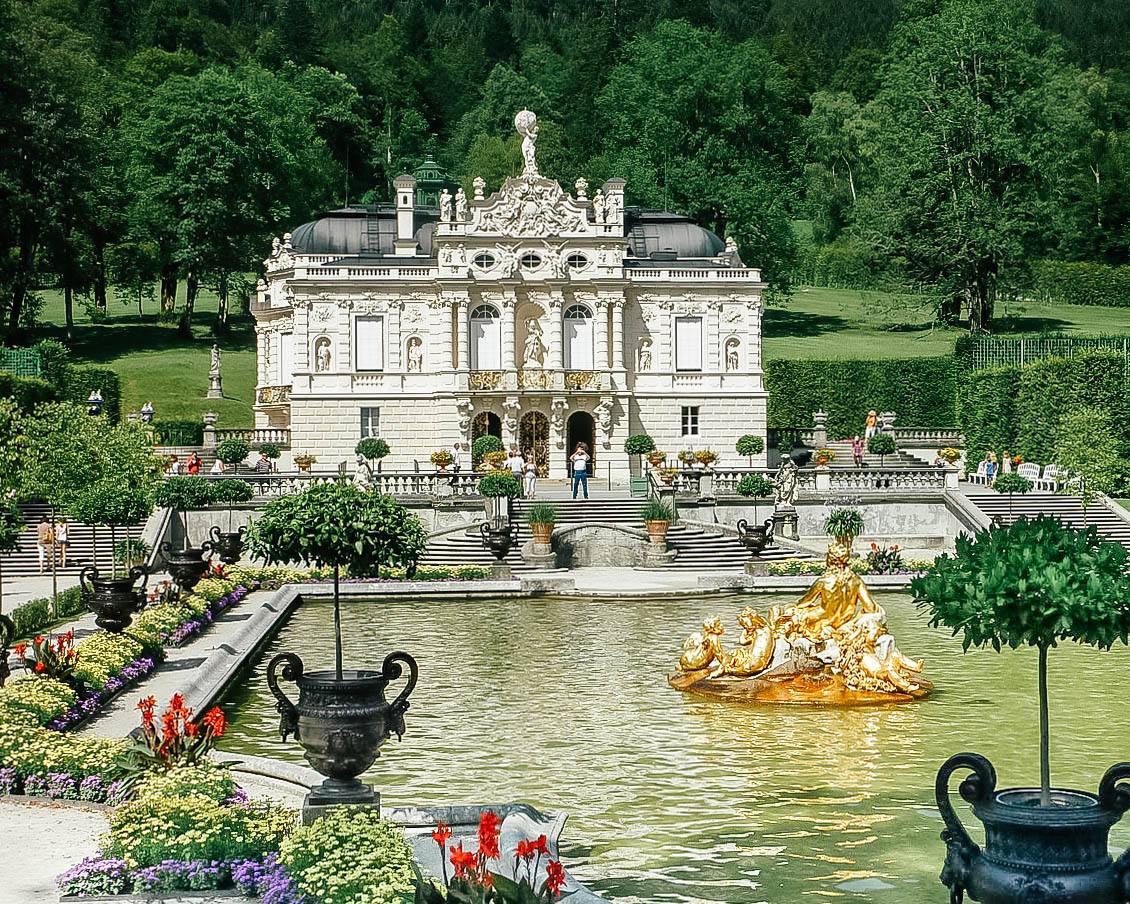
The stunning palace which is surrounded by an expanse of a lush green park was built by King Ludwig II on the foundations of a hunting lodge and forester’s house belonging to and used by his father Maximilian II. It was known to be his favorite castle and was lavished with priceless artwork and was equipped with modern electric lighting.
The inspiration for the palace was taken from the French model of Versailles’ Petit Trianon and it was actually intended to be the King’s refuge, as Petit Trianon was for Marie Antoinette.
It was the result of a long period of building and rebuilding and is actually the only large palace that King Ludwig himself lived to see completed.
*
What’s your favorite castle in Germany? How many of these castles have you visited? Let me know in the comments!
[su_row class=””] [su_column size=”1/2″ center=”no” class=””]
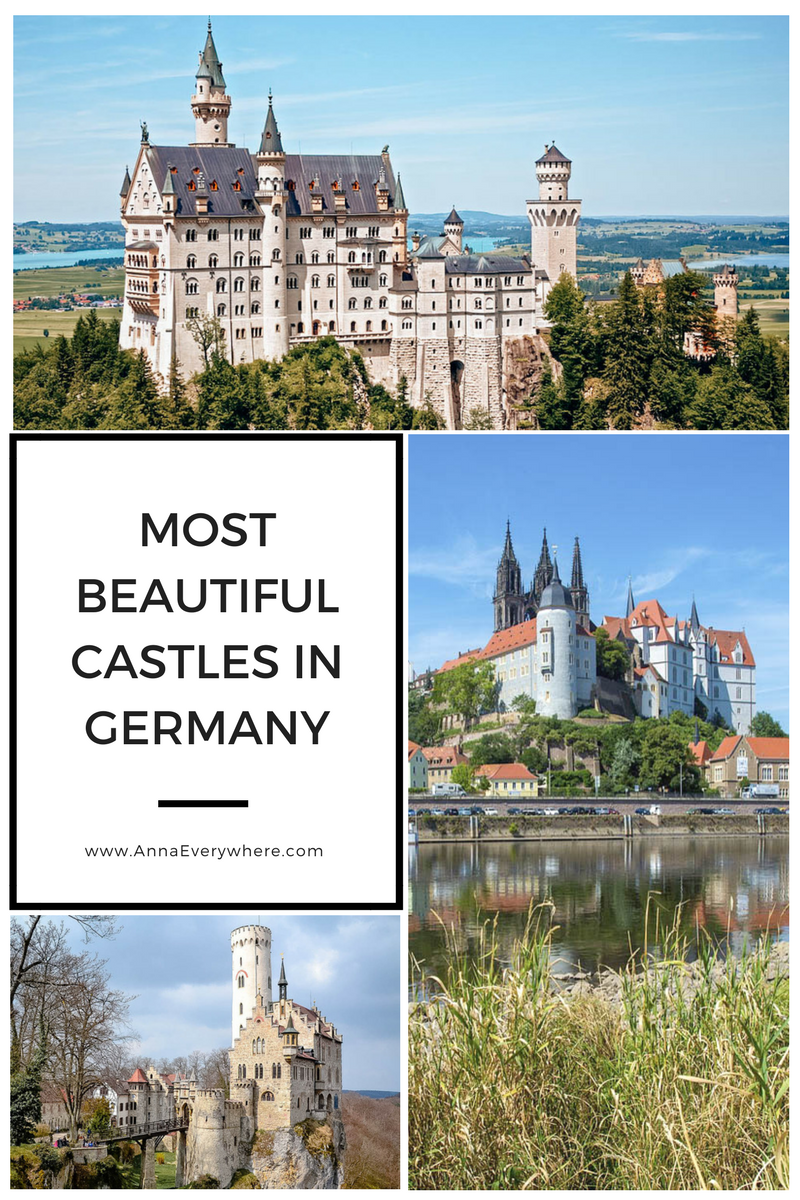
[/su_column]
[su_column size=”1/2″ center=”no” class=””]
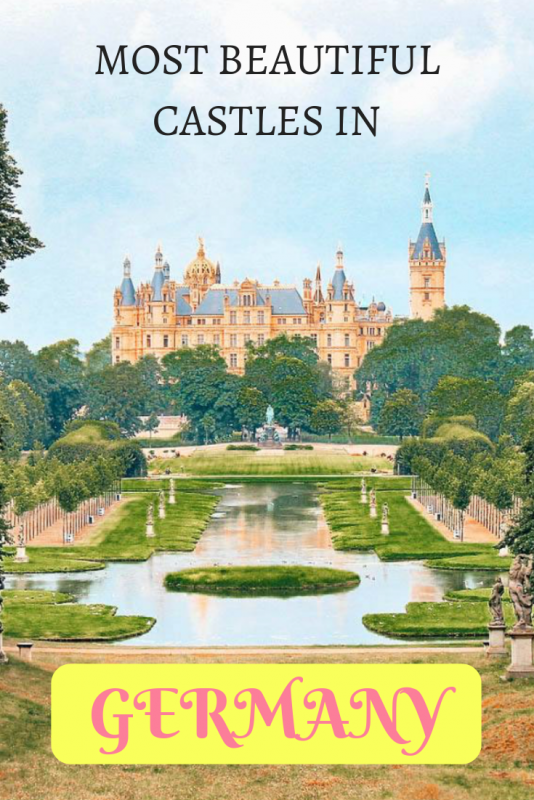
[/su_column] [/su_row]

Arunas
Monday 25th of March 2019
The Hohenzollern Castle looks fantastically stunning! I did not know that Germany has so many beautiful castles – I would really like to visit all of them. ????
Haley
Monday 25th of March 2019
I love the historical tidbits you included about each castle. They're all absolutely gorgeous, but hearing parts of their stories makes me want to visit them all the more.